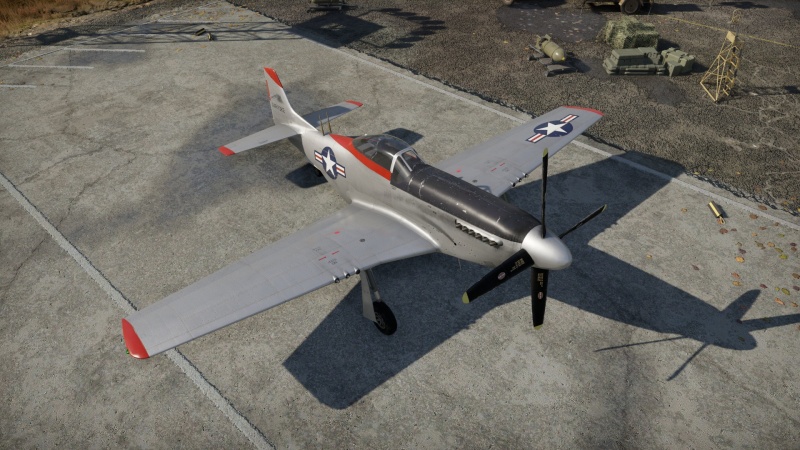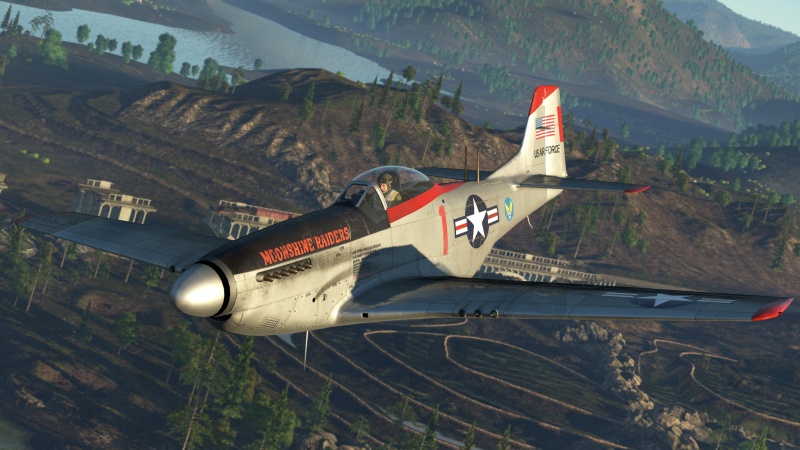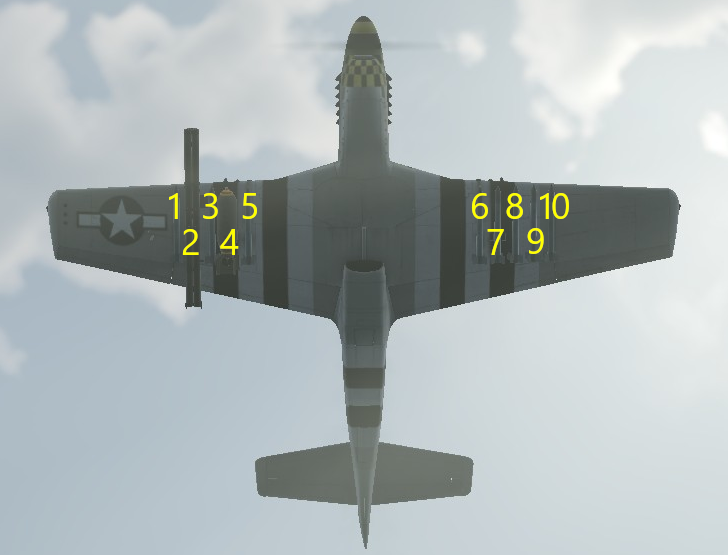P-51D-30
| This page is about the American fighter P-51D-30. For other versions, see P-51 (Family). |
Contents
Description
The P-51D-30 Mustang is a rank American fighter with a battle rating of (AB), (RB), and (SB). It was introduced in Update 1.33.27.0.
The P-51D was a further development of earlier Allison-engined P-51s in that it received the excellent Rolls-Royce Merlin engine which gave it excellent high-altitude performance. This, combined with excellent endurance, made the P-51 well-suited for bomber escort duties.
General info
Flight performance
In-game, the P-51D-30 runs a 75" boost that allows it to outspeed nearly every single vehicle at 5.0 BR. It possesses an above-average climb rate and good high-speed handling which makes it extremely well suited for Boom and Zoom. Additionally, bombs and rockets can be carried making the P-51 a good ground striker in Ground RB.
Use this plane as a Boom & Zoom fighter. Altitude and speed are your biggest friends while in combat. The P-51D has a laminar flow wing, hence it is fast and very agile at high speeds. The laminar flow wing reduces drag especially when going fast, which means that the aircraft turns best at high speeds. The P-51D out-dives nearly all opponents at 5.0, and is also very agile at high speeds. The plane has great endurance with its 1,880 rounds of ammo and 31 minutes of fuel minimum. Use this to your advantage.
It has a very high stall speed. You'd be better off to not stall in this plane. Only do it when necessary and when you know you're safe to do it. The P-51D-30 is not a turn fighter but is definitely manoeuvrable enough to dogfight at high speed. Optimal climb speed is 250 km/h IAS with WEP. The flaps are so strong you can deploy them in pretty much any situation in a dogfight. And even at 600+ km/h IAS, it takes a little bit of time for your flaps to break, takeoff flaps can be deployed at up to 510 km/h IAS.
| Characteristics | Max Speed (km/h at 6,400 m) |
Max altitude (metres) |
Turn time (seconds) |
Rate of climb (metres/second) |
Take-off run (metres) | |||
|---|---|---|---|---|---|---|---|---|
| AB | RB | AB | RB | AB | RB | |||
| Stock | 689 | 672 | 21.1 | 21.8 | 18.3 | 18.3 | 396 | |
| Upgraded | 754 | 721 | 19.1 | 20.0 | 28.8 | 22.7 | ||
Details
| Features | ||||
|---|---|---|---|---|
| Combat flaps | Take-off flaps | Landing flaps | Air brakes | Arrestor gear |
| ✓ | ✓ | ✓ | X | X |
| Limits | ||||||
|---|---|---|---|---|---|---|
| Wings (km/h) | Gear (km/h) | Flaps (km/h) | Max Static G | |||
| Combat | Take-off | Landing | + | - | ||
| 644 | 512 | 265 | ~11 | ~5 | ||
| Optimal velocities (km/h) | |||
|---|---|---|---|
| Ailerons | Rudder | Elevators | Radiator |
| < 500 | < 300 | < 500 | > 400 |
| Compressor (RB/SB) | ||
|---|---|---|
| Setting 1 | ||
| Optimal altitude | 100% Engine power | WEP Engine power |
| 2,400 m | 1,580 hp | 1,959 hp |
| Setting 2 | ||
| Optimal altitude | 100% Engine power | WEP Engine power |
| 6,400 m | 1,370 hp | 1,699 hp |
Survivability and armour
- 38 mm Bulletproof glass in front of the pilot.
- 19.05 mm Steel plate in front of the engine.
- 6.35 mm Steel plate between the engine and pilot.
- 15.87 mm Steel plate behind the pilot.
Modifications and economy
Armaments
Offensive armament
The P-51D-30 is armed with:
- 6 x 12.7 mm M2 Browning machine guns, wing-mounted (400 rpg inner, 270 rpg outer x2 = 1,880 total)
Due to the setup, the outer guns run out of ammo before the inner guns do so you only have 2 working guns once you've fired off 1,620 rounds.
Suspended armament
The P-51D-30 can be outfitted with the following ordnance:
| 1 | 2 | 3 | 4 | 5 | 6 | 7 | 8 | 9 | 10 | ||
|---|---|---|---|---|---|---|---|---|---|---|---|
| 100 lb AN-M30A1 bombs | 1 | 1 | |||||||||
| 250 lb AN-M57 bombs | 1 | 1 | |||||||||
| 500 lb AN-M64A1 bombs | 1 | 1 | |||||||||
| 1,000 lb AN-M65A1 bombs | 1 | 1 | |||||||||
| Mk 78 incendiary bombs | 1 | 1 | |||||||||
| HVAR rockets | 1 | 1 | 1 | 1 | 1 | 1 | 1 | 1 | 1 | 1 | |
| M8 rockets | 3 | 3 | |||||||||
| Maximum permissible loadout weight: 1,500 kg Maximum permissible wing load: 750 kg Maximum permissible weight imbalance: 550 kg | |||||||||||
| Default weapon presets | |
|---|---|
| |
Usage in battles
Offense
Probably the best assets the P-51D has are its speed, weaponry, and straight-line energy retention. If one climbs at the ideal speed of 250 km/h IAS side climbing is not necessary- a high enough altitude will be achieved by the time the first contact is initiated that the P-51D-30 can simply evade incoming fire and speed away, untouchable. It's still a good strategy to side-climbs in order to have amble time to build up speed before engaging the enemy as the P-51D-30 does not have good acceleration. A ~10 km distance will allows the P51D to go from 250 km/h IAS to almost 400 km/h IAS in a straight line.
When an enemy is spotted moving away from the P-51-D, enter a mild dive and go for a strafing run. After that, it is important to continue heading in the same direction so the speed is maintained. Doing this, even the most agile fighters won't be able to turn quickly enough to fire on you. If you miss on your strafe run or have an enemy behind you, you should get at least 2+km from the enemy and then start to turn towards him, depending on his speed. If your speed is under 500 km/h, a bigger distance should be achieved before attempting a turn. This ensures that your turn will be completed before the enemy gets within 1 km distance before you can line up your shot. Head-ons are actually very effective against fragile/lightly gunned vehicles such as the A6M and Spitfire. The high rate of fire and velocity of the 50 cals make long-range sniping very viable.
When engaging enemy bombers, aim for engines and wings. A good burst will rip off wings with ease and/or start several fires.
Defense
Contrary to popular myth, the P-51D-30 is not a good high-altitude fighter in-game. The P-51D-30 will maintain maximum manifold pressure from sea level to 1000 m and from 3000 m to 5000 m. Besides running away, avoid dogfighting at altitude outside of these areas or P-51D-30 will not be performing at its best. Most drastic lost of performance from 2000 m to 3000 m and above 6000m . This does not means that you should not climb above 5000 m. Always climbs as high as you can before engaging the enemy or running away as diving from altitude is the only way to quickly get above 500 km/h IAS. Furthermore, the P-51D-30 is near untouchable in a dive; though be careful, however, as planes such as the G.55S can and will catch a P-51 in a steep dive. In such a case, initiate a shallow dive which will make use of your superior energy retention and top speed. Almost all planes will reliably get to 600 km/h IAS in a dive but only few like the P-51 can get up to and beyond 700 km/h IAS.
Defensive dives are a strong suit of the P-51D as the flaps and airframe are very durable- spiral dives can easily rip the wings of more fragile Bf 109s and Spitfires. Should a pilot dare to do so and the situation allow it, a vertical dive at +500 km/h IAS will lock up almost all other fighters but the P51. Extend combat flaps and roll in a wide circle when the enemy comes within .5km to slow down and forces an overshoot. There will be a small window afterward when the enemy pull up for you to get some shots in but do not climb after the enemy for more than a few seconds, you do not have the energy for it and will stall out before they do.
It is possible in arcade to perform Pugachev's Cobra (due to the agility at high speeds) in some situations but should not be attempted unless you are at high speed and know what you are doing as it does require a large amount of skill to pull off successfully.
When flying against others, notable enemies are the Griffon/LF Spitfires, Fw 190 Ds, and Ta 152 H-1s. Each have to be handled accordingly when met: Griffon/LF Spitfires can be outrun, Fw 190 Ds can be out-turned, and Ta 152 Hs can be out-dived.
Due to the speed of the P-51D you may be able to outrun slower vehicles in a straight line (especially above 5 km) such as the Bf 109, Fw 190, and some heavier fighters and most ground attack aircraft. Coupled with light rolling and WEP you should be able to run from most dogfights.
Manual Engine Control
| MEC elements | ||||||
|---|---|---|---|---|---|---|
| Mixer | Pitch | Radiator | Supercharger | Turbocharger | ||
| Oil | Water | Type | ||||
| Not controllable | Controllable Not auto controlled |
Controllable Auto control available |
Controllable Auto control available |
Separate | Not controllable 2 gears |
Not controllable |
It's recommended to use Manual Engine Control with the P-51D-30 because of quite fast engine overheating. The D-30 has indefinite WEP and Meredith Effect modeled so radiator drag at high speeds is not an issue, even when fully opened they slow down the plane by up to 5 km/h.
The MEC controls on this plane are incredibly simple. Put out both radiators to 100%, and keep it like that for the whole game, as your engine will never overheat. Due to the position of the radiators, it gives a small amount of jet thrust to counteract the little drag it creates.
Pros and cons
Pros:
- Outstanding Boom & Zoom capability
- Above average climb rate
- Very high top speed at all altitudes
- Very agile at high speeds
- M2 Browning machine guns do decent damage and has high ammo, velocity and range
- Good cockpit visibility
- Decent payload options for ground attack
- Incredibly simple MEC (Manual Engine Controls)
- Good turn radius at high speeds
Cons:
- Fragile and catches fire easily
- Loses speed quickly in maneuvers.
- Sluggish manoeuvrability at low speeds
- Poor high-speed rudder control makes aiming difficult
- High stall speed (166 km/h)
- Minimum fuel load is rather big (weighs the plane down)
History
The North-American P-51 Mustang was an American fighter designed in the early 1940s and is considered the best US fighter of WWII. It was widely exported to countries in Europe, Asia, Africa and South America. The P-51 participated in the Korean War and other post-WWII conflicts.
The most famous Mustang version was the P-51D with teardrop (or bubble) canopy. The main problem for the pilots of the earlier variants was a huge blind spot at the rear of the aircraft due to the canopy design. An earlier attempt to address the issue was a British-designed Malcolm hood, installed on many P-51Bs. It improved rearward visibility, but the search for a better solution continued. In January 1943, USAAF's Colonel Mark Bradley, while stationed in Britain, was introduced to the then-new "bubble" canopy, designed for use on Spitfires and Typhoons. The canopy had no framework and offered near 360-degree vision. To install the new canopy, the rear fuselage section of the Mustang had to lose some height. However, this change required minimal redesign to the airframe. The inaugural flight of the new P-51D took place at Inglewood, California on 17th November 1943. The P-51D-30 was developed soon before the war ended. It mainly served in the Korean war.
| Archive of the in-game description | |
|---|---|
|
A single-seat all-metal cantilever monoplane fighter with a single engine, closed cockpit and retractable landing gear. The P-51D model Mustangs lacked one of the main flaws of the P-51B and P-51C models – poor visibility from the cockpit, particularly to the rear. The P-51D fighters received a new drop-shaped cockpit canopy without bracing, providing a perfect 360° view. Over time, the German Luftwaffe's resistance became weaker. Sightings of enemy planes in the sky grew rarer and rarer. This influenced the Mustang's continued evolution. Model P-51D aircraft were no longer painted – camouflage on the ground and in the air came to be considered excessive. The fighters now gleamed with polish metal. Its weight had decreased slightly, and its aerodynamics improved. On average, this resulted in a small addition to its speed. Mustangs then began to attack ground targets more often than air targets. They received rocket equipment to increase their efficiency as fighter-bombers and attack aircraft. The P-51D-30 could carry a "cluster" of three "tubes" – directional M10s, M14s or M15s for launching unguided M8 rockets. In place of these, it could also carry clips for the suspension of unguided 127 mm HVAR rockets. The P-51D was able to carry up to six heavy rockets along with suspended fuel tanks, and up to ten rockets without them. The aircraft's rocket armament significantly increased its ability to damage small moving targets. The P-51D became the most mass-produced Mustang model, a symbol of American aviation and one of the best fighters of World War II. In total, 8,156 of them were built. Apart from the RAF and USAAF, the P-51 was in service with France, China, Australia and the Netherlands during World War II. The P-51D remained in service with the USAAF for many years after World War II. In 1948, the USAF, newly formed as a separate type of army, abolished the letter "P" ("pursuit") as a designation for fighter and replaced it with the letter "F" ("fighter"). The designation P-51 changed to F-51 accordingly. | |
Media
- Skins
See also
Links to the articles on the War Thunder Wiki that you think will be useful for the reader, for example:
- reference to the series of the aircraft;
- links to approximate analogues of other nations and research trees.
External links
- [Ace of the Month] Major George E. Preddy Jr
- Official data sheet - more details about the performance
| North American Aviation | |
|---|---|
| Fighters | |
| P-51A | P-51 · P-51A |
| P-51C | P-51C-10 |
| P-51D | P-51D-5 · P-51D-10 · P-51D-20-NA · P-51D-30 |
| P-51H | P-51H-5-NA |
| Twin-engine fighters | F-82E |
| Jet fighters | F-86A-5 · F-86F-2 · F-86F-25 · F-86F-35 · F-100D |
| Strike aircraft | A-36 · PBJ-1H · PBJ-1J |
| FJ-4B · FJ-4B VMF-232 | |
| Bombers | B-25J-1 · B-25J-20 |
| Export/Licence | ▂B-25J-30 · ␗B-25J-30 |
| ▄Mustang Mk IA · F-6C-10-NA · ␗P-51C-11-NT · ␗P-51D-20 · J26 David · J26 · P-51D-20-NA · ␗P-51K | |
| F-86F-30 ▅ · ␗F-86F-30 · F-86F-40 ▅ · F-86F-40 JASDF▅ · ␗F-86F-40 | |
| ◄F-86K · ▄F-86K (Italy) · ▄F-86K (France) | |
| ␗F-100A · ▄F-100D · ␗F-100F | |
| Captured | ▅P-51C-11-NT |
| Canadair Limited license-built the F-86 as the CL-13 for use in Canada and export to Europe. | |
| Fiat license-built the F-86K for the Italian Air Force though another 120 NAA built F-86Ks were also sold to the Italians. | |
| See Also | Mitsubishi Heavy Industries · Canadair Limited · Fiat Aviation |
| USA fighters | |
|---|---|
| P-26 Peashooter | P-26A-33 · P-26A-34 · P-26A-34 M2 · P-26B-35 |
| P-36 Hawk | P-36A · Rasmussen's P-36A · P-36C · ○P-36C · P-36G |
| P-39 Airacobra | P-400 · P-39N-0 · P-39Q-5 |
| P-40 | P-40C · P-40E-1 · P-40E-1 TD · P-40F-10 |
| P-43 Lancer | P-43A-1 |
| P-47 Thunderbolt | P-47D-22-RE · P-47D-25 · P-47D-28 · P-47M-1-RE · ⋠P-47M-1-RE · P-47N-15 |
| P-51 Mustang | P-51 · P-51A (Thunder League) · P-51C-10 · P-51D-5 · P-51D-10 · P-51D-20-NA · P-51D-30 · P-51H-5-NA |
| P-63 Kingcobra | P-63A-5 · P-63A-10 · P-63C-5 · ␠Kingcobra |
| Prototypes | XP-55 |
| F2A Buffalo | F2A-1 · Thach's F2A-1 · F2A-3 |
| BF2C | BF2C-1 |
| F3F | F3F-2 · Galer's F3F-2 |
| F4F Wildcat | F4F-3 · F4F-4 |
| F4U Corsair | F4U-1A · F4U-1A (USMC) · F4U-1D · F4U-1C · F4U-4 · F4U-4B · F4U-4B VMF-214 · F2G-1 |
| F6F Hellcat | F6F-5 · F6F-5N |
| F8F Bearcat | F8F-1 · F8F-1B |
| Other countries | ▃Ki-43-II · ▃Ki-61-Ib · ▃A6M2 · ▃Bf 109 F-4 · ▃Fw 190 A-8 · ▃Spitfire LF Mk IXc |







